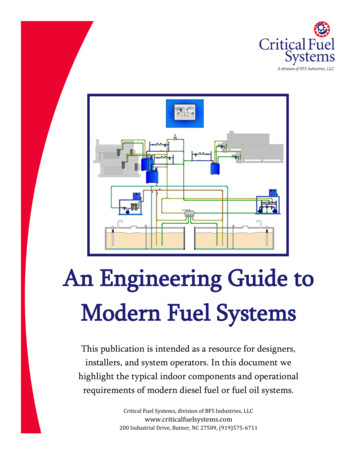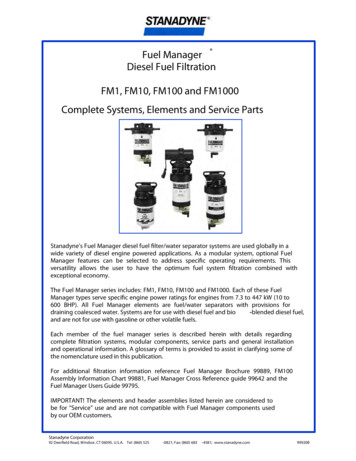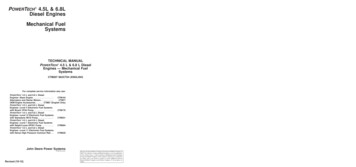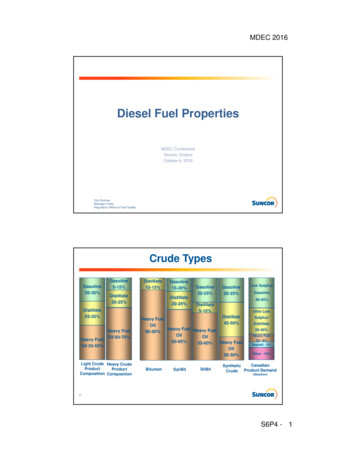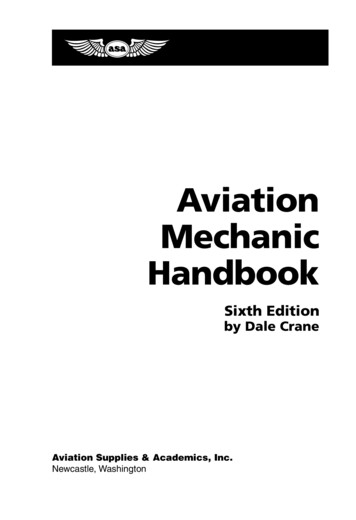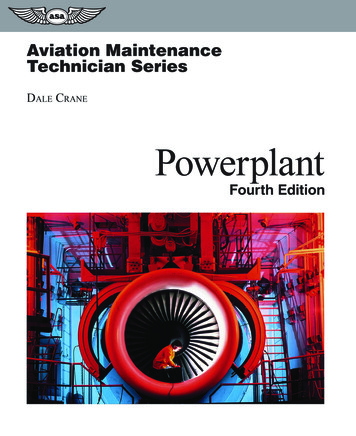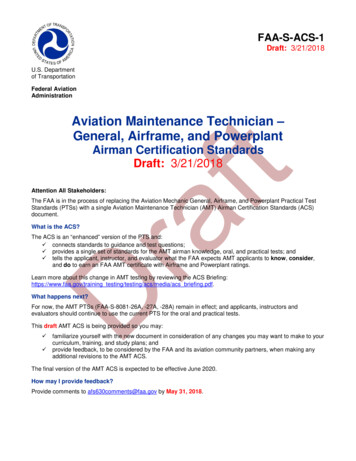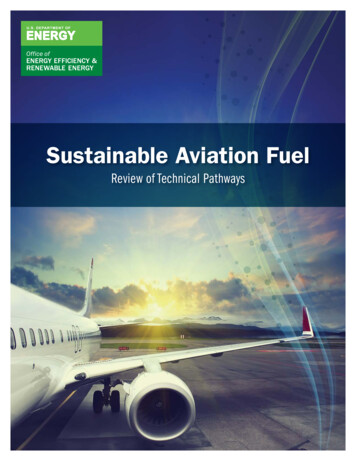
Transcription
Sustainable Aviation FuelReview of Technical Pathways
(This page intentionally left blank)
AcknowledgmentsThis report was prepared by Johnathan Holladay (Pacific Northwest National Laboratory), Zia Abdullah(National Renewable Energy Laboratory), and Joshua Heyne (University of Dayton) and is a compilation ofinformation synthesized from three workshops with additional new information inspired from the workshops.The authors are indebted to Michelle Kocal (LanzaTech), Steve Csonka (Commercial Aviation AlternativeFuels Initiative), Bill Goldner (U.S. Department of Agriculture), Mark Rumizen (Federal AviationAdministration), Carol Sim (retired Alaska Airlines, Washington State University), and Jim Hileman (FederalAviation Administration) for their poignant, challenging, and critical review of concepts in the report.The authors also thank Zia Haq, Liz Moore (U.S. Department of Energy, Bioenergy Technologies Office), andMohan Gupta (Federal Aviation Administration) for support.iii
AbstractThe 106-billion-gallon global (21-billion-gallon domestic) commercial jet fuel market is projected to grow toover 230 billion gallons by 2050 (U.S. EIA 2020a). Cost-competitive, environmentally sustainable aviationfuels (SAFs) are recognized as a critical part of decoupling carbon growth from market growth. Renewable andwasted carbon can provide a path to low-cost, clean-burning, and low-soot-producing jet fuel. Research showsan opportunity to produce fuel in which aromatics are initially diluted with the addition of renewable isoalkanes, aromatics are later fully replaced with cycloalkanes, and finally high-performance molecules thatprovide mission-based value to jet fuel consumers are introduced. Key to this fuel pathway is sourcing thethree SAF blendstocks—iso-alkanes, cycloalkanes, and high-performing molecules—from inexpensiveresources. When resourced from waste carbon, there are often additional benefits, such as cleaner water whensourcing carbon from wet sludges or less waste going to landfills when sourcing the carbon from municipalsolid waste or plastic waste. Jet fuel properties differ from gasoline and diesel, so research will be mostsuccessful if it begins with the end result in mind.iv
Sustainable Aviation Fuel: Review of Technical PathwaysList of AcronymsASTMASTM InternationalATJalcohol-to-jetBETOBioenergy Technologies OfficeBtuBritish thermal unit(s)CAAFICommercial Aviation Alternative Fuels InitiativeCo-OptimaCo-Optimization of Fuels & EnginesCORSIACarbon Offsetting and Reduction Scheme for International AviationDCNderived cetane numberDOEU.S. Department of EnergyEEREOffice of Energy Efficiency and Renewable EnergyFAAFederal Aviation AdministrationFTFischer-TropschGHGgreenhouse gasHEFAhydroprocessed esters and fatty acidsHTLhydrothermal liquefactionICAOInternational Civil Aviation OrganizationLCAlife-cycle analysisMFSPminimum fuel selling priceMSWmunicipal solid wasteNASANational Aeronautics and Space AdministrationNJFCPNational Jet Fuels Combustion ProgramNRELNational Renewable Energy LaboratoryOEMoriginal equipment manufacturerPNNLPacific Northwest National LaboratoryR&Dresearch and developmentSAFsustainable aviation fuelSPKsynthetic paraffinic kerosenesyngassynthesis gasTEAtechno-economic analysisUSDAU.S. Department of Agriculturev
Sustainable Aviation Fuel: Review of Technical PathwaysExecutive SummaryAirlines have committed to carbon-neutral growth in international commercial aviation beginning in 2021 andU.S. airlines have set a goal to reduce carbon dioxide (CO2) emissions by 50% in 2050 compared to 2005levels (Airlines for America 2020; IATA 2020). U.S. airlines have improved efficiency by 130% compared to1978 levels (Airlines for America 2020). Additional efficiency improvements in planes and engines are notlikely to be enough. Meeting the 2050 goal will required fuels that have a lower carbon footprint, referred to assustainable aviation fuel (SAF)—defined by the International Civil Aviation Organization (ICAO) asalternative aviation fuels that “(i) achieve net GHG [greenhouse gas] emissions reduction on a life cycle basis;(ii) respect the areas of high importance for biodiversity, conservation and benefits for people fromecosystems, in accordance with international and national regulations; and (iii) contribute to local social andeconomic development, and competition with food and water should be avoided” (ICAO 2018).One challenge for providing SAF is that the size of the jet fuel market is large and growing. Global demand isexpected to increase from 106 billion gallons in 2019 to 230 billion gallons in 2050 (U.S. EIA 2020a). Thedomestic market in 2019 was 26 billion gallons, exceeding 3 quadrillion British thermal units (3 quads) (U.S.EIA 2019). This market could consume several hundred million tons of biomass per year, which is consistentwith the current availability of biomass in the United States (340 million tons) (Langholtz, Stokes, and Eaton2016).A second challenge is that the price of SAF today is higher than petroleum-based Jet A fuel. Fuel price is ahurdle because fuel is 20%–30% of the operating cost of an airline (IATA 2018). Research and development(R&D) can help bring the cost down.Unlike light-duty vehicles, the low energy density of even the best batteries severely limits opportunities forelectrification. 1 While many are working on electrification, efforts are for smaller aircraft and airlines willhave no alternative for some time but to use SAF to operate in a GHG-emission-constrained future.0FPart I of this report provides an overview of commercial jet aviation fuel: how it compares to fuels for cars andtrucks, its composition, its specification, and its certification process.Jet fuels consist of n-alkanes, iso-alkanes, cycloalkanes, and aromatics. Aromatics do not burn as cleanly asalkanes, resulting in higher particulate emissions, and have lower specific energy. The n-alkanes are acceptablebut do not meet fluidity and handling properties, limiting their blend potential. The iso-alkanes have highspecific energy, good thermal stability, and low freezing points. Cycloalkanes bring complementary value toiso-alkanes, providing the same functional benefits as aromatics by enabling fuels to meet the densityrequirement and potentially providing the seal-swelling capacity provided today from aromatics. Combined,iso-alkanes and cycloalkanes offer the potential to add value to a fuel by enabling high specific energy andenergy density and minimizing emission characteristics. The U.S. Department of Energy (DOE) is evaluatingthe hypothesis that improved fuel energetic properties (i.e., specific energy and energy density) may provideincreased range, higher payload capacity, or fuel savings.Original equipment manufacturer (OEM)-led ASTM D4054 fit-for-purpose testing generally costs severalmillion dollars and can require years to be approved (ASTM 2018). A fast-track approval process has beenaccepted for fuels in which the SAF blending component is limited to 10% and consists of the same types ofmolecules that are in petroleum-based jet fuel. A clearinghouse annex has also been proposed to reduce costand time for approval. The Bioenergy Technologies Office (BETO), Federal Aviation Administration, andU.S. Department of Defense are investing in prescreening and testing protocols that need only small quantities(milliliters to liters) to provide feedback about a candidate fuel blend fit-for-purpose. To date, there are six1Jet fuel has an energy density equal to 43 MJ/kg, while lithium-ion batteries in today’s electric vehicles have an energy density equal to 0.72 MJ/kg (200Wh/kg). The amount of weight severely limits battery use in large passenger aircraft.vi
Sustainable Aviation Fuel: Review of Technical PathwaysASTM International (ASTM) D7566-approved SAFs for use in up to 10% to 50% blends. The SAF initiallycomposed of n- and iso-alkanes now include all four hydrocarbon families listed previously and are producedfrom synthesis gas (syngas); fats, oils, and greases; sugars; and alcohols.Part I finishes by summarizing the learnings from three BETO-supported workshops. These include theAlternative Aviation Fuel Workshop held in Macon, Georgia, in 2016, which focused on SAF production; theJET workshop held in Cleveland, Ohio, in 2017, which focused on high-performance fuels; and the TrilateralBiojet Workshop held in Richland, Washington, in 2018, which focused on jet fuel R&D collaborationsbetween Canada, the United States, and Mexico. Some of the key learnings from these workshops include: The aviation industry seeks to reduce its GHG emissions significantly, decoupling airline growth fromcarbon growth. The current cost of SAF is high. Airlines are willing to support SAF development by purchasing somefuel at a higher price, but for SAF to scale, prices need to be reduced. OEM-led ASTM D4054 approval and evaluation process is expensive and time-consuming. Developingnew engines is even more onerous regarding timescale and cost, and hence a program coupling fueldevelopment and engine development R&D would not help overcome industry barriers. Existing engines can use fuels that have a much higher heat of combustion than Jet A, and specificenergy (i.e., heat of combustion) increases can deliver greater range, higher payload capacity, ordecreased fuel consumption. More sources of low-cost feedstock are required as fats, oils, and greases are not currently available inenough volume to meet SAF demand. The use of cover crops to increase availability of oil seeds while improving soil quality as well as use ofother lipid-rich streams, such as manures and sludges, may increase availability. Processes for theirconversion will need to be approved through ASTM. Techno-economic analysis (TEA) and life cycle analysis (LCA) are inconsistent across the SAF industry,but the consistent message from most models is that the main cost drivers are feedstock costs, yields, andplant capital recovery. Current policies are skewing renewable fuels towards diesel and away from the jet market.Part II provides insights resulting from a study of the aviation fuel industry, challenges of and successes withthe approved pathways, and BETO capabilities and R&D portfolio. The insights focus on reducing cost andoptimizing the value proposition for SAF. SAF in the future may include strained or otherwise novelmolecules that are not found in conventional fuels, if the molecules can be produced at low cost. Researchshows an opportunity to produce fuel in which aromatics are initially diluted with the addition of renewableiso-alkanes, aromatics are later fully replaced with cycloalkanes, and finally high-performance molecules thatprovide mission-based value to jet fuel consumers are introduced. To accomplish this transition and reducecosts to improve the value proposition, efforts in the following areas will be helpful: Understanding properties of cycloalkanes and production routes from biomass Developing process-intensification strategies as a means of reducing capital cost “Solving another problem” as a means of improving the value proposition Reducing cost and improving value of low-value process streams of currently approved pathways Understanding scaling requirements that make sense to the industry as a means of reducing cost.Examples of work could include the following:vii
Sustainable Aviation Fuel: Review of Technical Pathways In the near term (0–5 years), research can help further reduce the cost of existing approved pathways toiso-alkanes and synthetic paraffinic kerosene molecules. Research could include low-cost routes tocycloalkanes, including alkylated cyclohexanes, and understanding the properties of molecules withvarious ring structures available from catalytic, biological, thermal, and hybrid approaches. Public–private partnerships and collaborations across agencies may accelerate cost reductions byensuring a diverse set of stakeholders are involved early in the solution to ensure it can address barriersfor industrywide use. In the longer term, as SAF volumes increase, aviation fuels may provide better performance and reducedemissions (i.e., soot). Use of nontraditional raw materials including carbon oxides, methane, deconstructed plastic, and otherwaste materials may keep cost in parity with conventional fuels.BETO’s R&D capabilities and feedstock/technology portfolio provide tools for meeting the technical needsto overcome hurdles preventing SAF deployment, including cost reduction.viii
Sustainable Aviation Fuel: Review of Technical PathwaysTable of ContentsExecutive Summary . viIntroduction. 1Part I – Background. 21Jet Fuel Markets. 31.1 Jet Fuel Versus Ground Transportation Fuel Markets . 31.2 How Is Jet Fuel Similar to and Different from Other Transportation Fuels? . 51.3 Why Invest in SAF? . 72Jet Fuel Specifications . 72.1 Properties: Performance, Operability, and Drop-In Requirements. 82.1.1Performance . 82.1.2Operability . 82.1.3Drop-In . 92.1.4Other Properties . 102.1.5Fuel Properties Derived from Bulk Versus Trace Composition . 102.2 Molecular Families in Jet Fuel . 102.2.1n-Alkanes and iso-Alkanes . 122.2.2Aromatics . 122.2.3Cycloalkanes . 132.2.4Blended Fuels. 142.3 Beyond Current Fuels – High Performance. 142.4 Review of Chapter 2 . 153Jet Fuel Certification . 163.1 Getting a Fuel Approved . 163.2 A Fast Track to ASTM Approval . 183.3 Currently Approved and Emerging Fuels . 193.4 Summary of Current SAFs . 204Workshop Learnings . 214.1 Alternative Aviation Fuel Workshop. 224.2 JET Workshop . 234.3 Trilateral Canada–Mexico–U.S. Biojet Workshop . 23Part II – Analysis and Insights . 255R&D – Fuel Molecules . 265.1 Vision: Reduce Aromatic Content and Increase iso-Alkanes and Cycloalkanes . 265.2 High-Quality iso-Alkanes . 285.2.1Crack Large Molecules . 295.2.2Build Up Small Molecules . 315.2.3Direct Fermentation . 325.2.4Summary . 32ix
Sustainable Aviation Fuel: Review of Technical Pathways5.3 Alkylcycloalkanes, Six-Carbon Rings . 335.3.1Zeolite-Catalyzed Aromatization Followed by Hydrotreating . 345.3.2Phenol Hydrogenation. 355.4 Cycloalkanes, Other Ring Sizes, and Fused Rings . 365.4.1Ring Contraction . 365.4.2Ring-Forming Reactions . 365.4.3Ring Motifs in Wood Extractives and Fermentation. 365.4.4Esoteric Cycloalkanes . 375.5 Low-Aromatic, High-Energy-Content Fuel Properties . 385.5.1Gaps in Understanding Cycloalkane Properties . 385.5.2Quantifying the Value of SAF . 395.6 Quantifying the Value Added with SAFs . 405.7 Summary of Fuel Molecules. 406R&D -- Cost Reduction . 416.1 Feedstock-Related Research . 416.1.1“Solve Another Problem” . 416.1.2Collected Carbon from Existing or Developing Processes . 426.1.3Waste Gases . 426.1.4CO2 as a Carbon Source . 426.2 Reducing Capital Cost . 446.2.1Use Current and Distressed Infrastructure . 446.2.2Petroleum Refinery Integration . 456.2.3Separations . 456.2.4R&D Needs for Small-Scale Distributed Refineries . 456.3 Rethinking Biorefineries. 466.3.1Sugars to Products, Lignin to Fuels . 466.3.2Focus R&D on Conversion Platforms That Provide Product Flexibility . 466.3.3Feedstock Flexibility to Use Full Capacity . 476.4 Sourcing Hydrogen . 486.5 Analysis of Cost Reduction . 486.6 Summary of Cost Reduction. 497Summary and Insights . 497.1 An R&D Strategy for SAF . 497.2 Insights on R&D . 507.2.1Focus R&D on Low-Cost iso- and Cycloalkane Production . 507.2.2Focus on Low-Cost Feedstocks . 517.2.3Focus R&D on Conversion Platforms that Provide Product Flexibility . 517.2.4Provide Replacement for Hydrogen Gas in Distributed Processing . 517.2.5Refine and Expand Analysis . 517.2.6Sequencing R&D to Achieve Impact in the Short, Medium, and Long Term . 527.3 Cooperative Opportunities for R&D . 527.3.1Collaboration Between the National Laboratories . 527.3.2Intersection with FAA Center of Excellence and USDA . 52x
Sustainable Aviation Fuel: Review of Technical Pathways7.3.37.3.4Intersection with North American Partners . 53SAF Working Group . 53References . 54Appendix 1. Bioenergy Technologies Office Mission. 58Appendix 2. ASTM Fuel Approval Prescreening Tests . 59Appendix 3. Workshop Learnings. 60A3.1 Macon Workshop . 60A3.2 Cleveland Workshop . 61A3.2.1 Two Schools of Thought . 61A3.2.2 High-Performance Fuel Options . 61A3.2.3 Engine and Combustor Options . 62A3.2.4 Aircraft On-Board Considerations . 64A3.2.5 High-Performance Fuel Development to Deployment. 65A3.2.6 Key Takeaways . 66A3.3 Richland Workshop . 66A3.3.1 Synopsis of the Workshop Report. 67A3.3.2 Key Takeaway Messages . 67xi
Sustainable Aviation Fuel: Review of Technical PathwaysList of FiguresFigure 1. U.S. transportation fuel consumption (billions of gallons per year) (U.S. EIA 2017) .3Figure 2. Major U.S. refined products pipelines carrying jet fuels (Airlines for America 2018) and the 10largest airports by traffic volume. 5Figure 3. Carbon numbers and boiling points for gasoline, jet, and diesel fuels .6Figure 4. U.S. renewable fuel production in 2018 (U.S. EPA 2019) .7Figure 5. Composition of an average Jet A (POSF 10325) (Edwards 2017). n-Alkanes, iso-alkanes,cycloalkanes, and aromatics are approximately normally distributed across the carbon number range.A molecule with 11 to 12 carbons is approximately average. . 11Figure 6. Various examples of fused and strained molecules . 13Figure 7. Performance metrics of a fuel can be clumped into nine categories that are dependent on themission of the flight . 14Figure 8. Four-tiered process for testing new aviation fuels and fuel additives, per the ASTM D4054,Standard Practice for Evaluation of New Aviation Turbine Fuels and Fuel Additives . 17Figure 9. ASTM-D4054 Fast Track Annex for qualification and approval of new aviation fuels that meetthe compositional and performance standards with a limit of 10% blend (highlighted portion differscompared to Figure 8) . 19Figure 10. SAF pathways approved under ASTM D7566 and emerging fuel pathways in the ASTMD4054 approval process . 20Figure 11. Summary of four classes of hydrocarbons. 21Figure 12. Energy density and specific energy of various hydrocarbons . 26Figure 13. Strategic focus on iso-alkanes and cycloalkanes. 28Figure 14. iso-Alkane production by cracking and isomerizing large molecules, building up smallmolecules, or fermentation. 29Figure 15. Lipid sources for HEFA, including waste sources and crops. 30Figure 16. Routes to cyclohexanes that can be synthesized in the jet-fuel range . 34Figure 17. Smaller and larger rings from 3 to 8 carbons . 36Figure 18. New ring structures, fused rings, and different ring sizes from nature . 37Figure 19. Esoteric molecules under examination for fuel properties . 38Figure 20. CO2 from ethanol production conversion to jet fuel via synthesis gas . 44xii
Sustainable Aviation Fuel: Review of Technical PathwaysList of TablesTable 1. Performance Properties . 9Table 2. Operability and Drop-In Requirements . 9Table 3. Fuel Properties Derived from Either Bulk or Trace Components . 10Table 4. Comparison of Three Jet A Fue
The 106-billion-gallon global (21-billion-gallon domestic) commercial jet fuel market is projected to g
